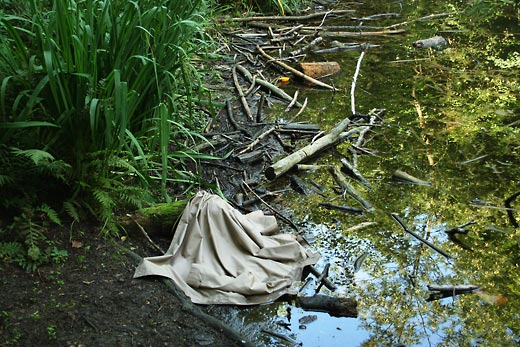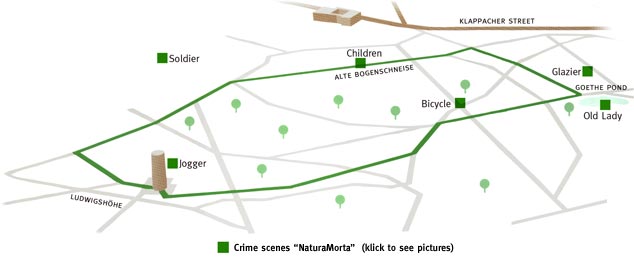// Alba D'Urbano
//

Main;
Projects() {
Esposizione Impraticabile();
Mare();
Der negierte Raum();
Hautnah();
Touch Me;
Stoffwechsel;
Il Sarto Immortale();
Die Wunderschöne Wunde;
Tra cielo e terra;
L'età dell'oro();
Venere;
Private Property();
Monitoraggio;
corpo_insegnante();
Natura Morta() {
}
Redden/Erröten; Son_no;
Airbag;
Collaborations();
Net-Works();
History();
Imprint;
Natura Morta () {
The Project;
}
// with Jörg Brombacher
//2006

In "Natura Morta", the forest is seen as a cultural landscape, a projection screen for human imagination, and, in particular, this project explores the themes of media entertainment and fear.
From Ancient Greek myths to Romanticism, from popular fairy tales to high-brow literature, music and the fine arts, the forest has repeatedly been assigned different meanings in Western culture. Today, in our "mediafied" society of the spectacular, it has been reduced to a media backdrop. As a recreational park, the forest is a picturesque setting for special experiences of nature – sometimes artistic experiences too – or a place for healing practices, a platform for orgies of all kinds of sport activities.
To realize this project, Bessunger Forest in Darmstadt was partly transformed into a scenic "Laboratorium". The complete orchestration consisted of a series of different stations forming a show-jumping course. A very special kind of path, which alluded to the film and entertainment industry by means of its narrative character, and carried visual associations with the Disneyland aspect in today's understanding of the forest. The individual stations were constructed from simple elements, designed to "maybe" evoke past or frightening events of criminal activities.

Paul Hermann Gruner, a journalist and crime novelist from Darmstadt, wrote "Fiat Lux", a short fairy tale-cum-crime story for the installation. The "crime scenes" of the story were the police headquarters, the pond, the Goethefelsen, the tower, the "U-Boot" and the US Army barracks; the invisible actors were an old lady, a 14 year-old girl on a bike, a master glazier, two elementary school pupils, a student and an American soldier.
From a distance, the installations were integrated into their natural setting
to such an extent that the illusionary power of the "forest images" generated
by them left the observer mostly seeing these as crime scenes of "real" events.
This also led to occasional negative reactions and calls to the local police.
Moreover, minor instances of vandalism of the stations and theft transformed
the fictive into real "crime scenes": Even before the opening of
the exhibition, a file was opened for the project at the Darmstadt police
bureau.